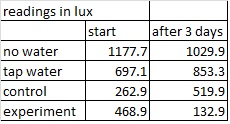After a very short deliberation - someone mentioned looking at a way of purifying water - we decided to investigate the usefulness of using bivalves as biofilters.
Now there is plenty of research out there about the use of bivalves - freshwater mussels in most cases - so I will not add to that. What I will do is talk about what we found and some advice for anyone who fancies having a go at this experiment themselves.
Ok in all good experiment methods let us start with the equipment set up;
- A net of freshwater mussles (alive) from the meat counter at your local supermarket.
- Two large (we used 30 litre) fish tanks for experimentation (1 for control, 1 for dirty water).
- A light sensor - we used a plug and play data logger.
- A light to shine through samples.
- Cuvettes for taking readings.
- Pippettes for water sampling.
- 'Dirty water' - ours had sand, dirt, silt and stagnant water in it.
The water had seemed cleaner however the transmission of light through the sample was not higher - as you might expect - but lower. This would indicate that the bivalves had not cleaned the water at all. However as disappointing as this was it was not the worst thing that had occurred...
All of the mussels had died over the weekend. The smell was atrocious - something my classes were not slow at pointing out. When I say atrocious I mean it it was a rancid smell - which was fun trying to get over sensitive Y9 girls to ignore it and concentrate on their work.
However we set up a second experiment this time though we reduced the number of bivalves used (6) - to hopefully stop them dying.
The results from this second experiment were much more promising;
As you can see from the graph the level of transmitted light through the water increased during the sampling time. This means the water - in our very crude experiment - was getting cleaner and more like the control/tap water. Unfortunately the bivalves again died - we believe (someone said) this was due to the build up of Nitrogen in the tank.
Now the point of this article...
- Having an experiment set up in your lab is a really good way of drawing students into science - questions get asked, makes you seem like you actually like doing science, it is something out of the norm and a bit different.
- This experiment does need repeating - I would be interested to see if anyone else could improve on it or find some better (more robust) data.
- Science is fun and this is a really good experiment to show this - it uses a live animal and relates to a real world issues (the presence of clean drinking water). There are probably loads of fairly simple experiments that would easily link to the real world and not require a large amount of resources or time to do.
- Often there is plenty of equipment in a science department prep room which never gets used. Investigations like this are a great way of utilising this forgotten equipment. In my experience technicians are often more than happy to advise and instruct you on the use of the dusty stuff at the back! (providing you ask really nicely)
- Finally if you are keen on doing this experiment or any experiment using bivalves or fish please please please make sure you start with a small amount of organisms because the smell when they die is just horrible!
Ooooh finally finally, I know there might seem to have been lots wrong with the method but this was a simple experiment put together in order for science club to try something different. We had planned to move on to a move expansive experiment but then I moved schools and it all got scrapped!
So in other words I do know how to do a proper science experiment, honest!
Have fun with it if you try it or use the comments to tell me of any short science experiments you may try/use at school or home.


No comments:
Post a Comment